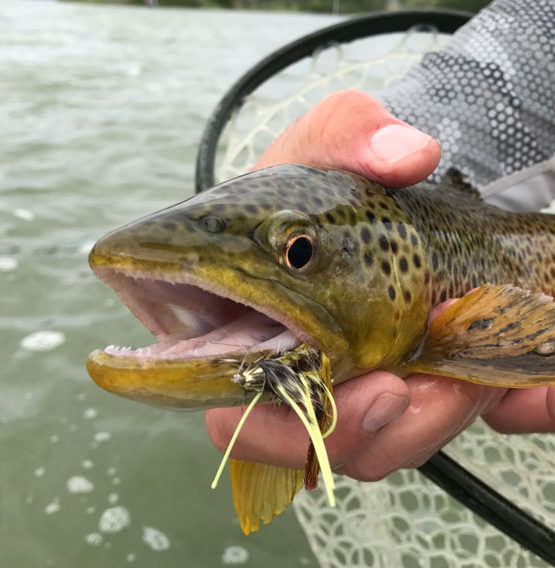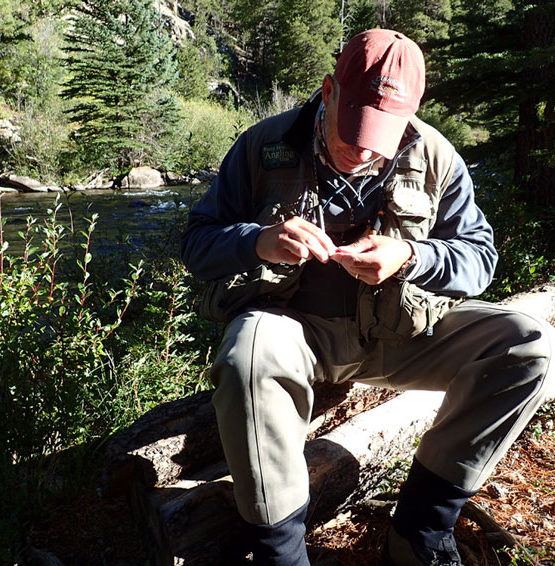As you develop your fly fishing skills, you’ll want to add the killer “dry dropper” rig to your arsenal. Not only is dry dropper a cool bit of fly fishing gloss to drop around the grill at your next summer barbecue, this simple, dual-fly setup marries the benefits of a dry or terrestrial fly presentation with the enhanced trout-catching potential a nymph and a two-fly rig both provide. With that in mind, before describing how to set it up, let’s first answer the question: What is a dry dropper rig?
In its simplest form, a dry dropper rig consists of a larger dry fly in the first position, either tied to the end of your leader or, if you’ve tippet-extended your leader, at the end of your first section of tippet. The “dropper” is typically a smaller nymph tied to a second section of tippet that trails off the hook of the leading dry fly.
Disclaimer: This post may contain affiliate links, meaning we will receive a small commission (at no cost to you) if you click through and make a purchase.How To Tie A Dry Dropper Rig
Great news! Aside from a single fly rig, the dry dropper combination may be the easiest two-fly rig to set up, cast and see on the water. Here’s a simple step-by-step guide.
Side Note: For the sake of this post, we’ll assume we’re fishing a medium sized Western U.S. river with a 9 foot, 5 weight rod that is strung with standard 5 weight line. We’ll also assume that it’s middle to late summer, that the trout in our river are modestly leader shy and that the water is running clear and on the low side of normal.
Step 1 – Attach Your Leader
Assuming a somewhat leader wise audience, and that your first fly will be dry, you’ll want to keep your line a bit further behind your first fly. Therefore, we recommend a 9 ft. tapered, sink-resistant leader. While we prefer Rio’s Freshwater Powerflex Trout Leader, there are plenty of excellent leaders on the market.
Attach your leader to your line at the leader’s butt end section (the thicker end) with either a Nail Knot or simple “Handshake Loop Knot.”
Step 2 – Extend Your Leader With Tippet (Optional)
Although not absolutely necessary for a dry dropper rig, some anglers choose to extend their leader with a section of tippet. If you do so, it’s really only done to extend the life of your leader, so we recommend keeping this length of tippet under twelve inches. The best knot for this connection is a simple Surgeon’s Knot, well-trimmed, of course.
Step 3 – Attach Your First Fly
The fun of a typical dry dropper rig is being able to use a nice, big, easy-to-see fly that will serve as both a hungry trout enticement and as a strike indicator for the trailing dropper.
Using a terrestrial, such as a Joe’s Hopper, Amy’s Ant or a more fly-like attractor like a Humpy, Irresistible or Stimulator is the ticket here, however, a more delicate dry dropper rig can certainly be set up with a less ostentatious lead bug.
For the first fly in a dry dropper rig, the main ideas are:
- To tie on something that mimics what’s buzzing and/or hopping around you.
- To tie on a fly that isn’t going to easily sink from the weight or drag of the second “dropper” fly.
- (Since it serves the role of strike indicator for dropper fly takes), to tie on something that isn’t difficult to see.
Use a standard Clinch Knot to tie on your first fly. However, since takes on a juicy lead fly can be rather ferocious, you may want to improve your Clinch Knot.
It’s also a good idea to thoroughly dress your lead fly with a good dose of floatant. I like to apply floatant to the first fly after I’ve setup the whole rig. That way, I’m much less likely to get floatant on the second section of tippet or the trailing fly.
Step 4 – Connect Your Second Tippet Section
In a typical dry dropper setup, the second tippet section varies in length by what the angler is trying to do. For instance, if the trailing fly is intended to float closer to the surface, say, to mimic a surface-foam midge emergence, the second section of tippet should not exceed twelve inches.
If, on the other hand, the second fly is a heavier bead-headed number that you want to have dance among the deeper rocks, the second section of tippet might need to be a bit longer. Depending upon river depth, I’ve deployed second tippet sections that have exceeded three or four feet.
Being careful not to jack up the appearance of the lead bug, attach this section of tippet to the first fly’s hook bend with a standard Clinch Knot. Because of its invisibility and greater propensity to sink, we recommend fluorocarbon tippet for the second section of tippet.
Step 5 – Attach Your Dropper
As we’ve been discussing, depending upon what you’re trying to imitate, the second “dropper” fly may be as small as a #22 RS2, or as big as a #14 Prince with a tungsten bead head (better have a big and buoyant lead bug for this dropper, by the way). Simply Clinch Knot this second fly to the end of the second section of tippet, trim it up, give the whole two-bug unit a gentle tug, apply your floatant to the dry fly, and you’re ready to unleash your superior intellect on (hopefully) unsuspecting trout.
To Use Or Not To Use A Second Dropper?
If two flies are good, three flies MUST be great, right? Well… maybe. Upon occasion, I have ventured into the “dry double-dropper” realm. If you choose to venture here, be advised that the more sections of delicate string you marry with fuzzy-hooky things, the more likely you are to wind up with a snarl of epic proportions. Believe me, it’s the pits detangling or re-rigging during a ping-pong style dry dropper, feeding fest.
The Best Time Of Year To Fish A Dry Dropper Rig
Here at Fly Fishing Fix, we pride ourselves on knowing a fair amount about fly fishing. However, since we have no idea where in the world you’re planning to fish, there is no specific season when a dry dropper rig can’t be used.
That said, a dry dropper rig is most effective when both fly types are naturally present and active. In our home state of Colorado, for example, we probably aren’t going to draw the slightest sniff on a Chernobyl Ant in early February. You get my point.
In short, dry dropper rigs are best fished in summer and early fall, when trout are more inclined to attack a big dry fly while also feeding on subsurface morsels.
Good Dry Dropper Fly Combinations
Adding to the fun of a dry dropper rig is the unlimited combination of flies with which one can experiment. Here are a few examples of things I’ve tried over the years:
- The Hopper Copper Dropper – This combination has been a go-to for many an angler for quite a few years. Use any hopper in the lead bug position (I like a Joe’s Hopper for this combo) and trail a standard Copper John as your dropper.
- The Denver Bronco – Lead bug: Orange Body Stimulator. Trailer: Blue Copper John. This fly combination used to be SUPER, but it just hasn’t been very good lately.
- Merry Christmas – Lead bug: Olive Hopper (or Green Body Stimulator) with a red trailing nymph, such as a Red Copper John, Blood Midge or Red Zebra Midge. I like fishing this under a pine tree in the morning.
- Gorilla on a Trike – Lead bug: anything big and furry, such as a Yellow Humpy or Stimulator. Trailing dropper: Trico nymph imitation, i.e. a Mercury Baetis, Black RS2. After you catch a big brown trout on this rig, you’ll be strangely compelled to climb up a tall rock and beat your chest.
- Big ‘n Tasty – Lead bug: Amy’s Ant. Trailer: Bead Head Prince. For one glorious 45-minute afternoon stretch on the North Platte several years ago, I got blisteringly hot on this combination. Since then, it has held a special place in my soul, right there next to the Quarter Pounder with Cheese.
- Baetis Buddies – Doubling up an adult with its nymphal precursor can be done with just about any aquatic born fly. In this case, the lead Baetis pattern might be a larger Callibaetis (i.e. Adams, Blu Dun or Cripple Callibaetis) with a Baetis nymph or emerger as your dropper. I also love the buddy-up concept when a Caddis hatch is afoot.
- Drake & Bake – If you see Drakes coming off, it can be an epic experience to employ a big Drake pattern as your lead fly while trailing a Flashback Pheasant Tail a couple of feet behind it. If the trout are hammering the dry to the exclusion of the trailing nymph, ditch the dropper and just enjoy your exciting ride on the Drake Express.
Related Content:
Final Thoughts
When it’s on, a successful dry dropper session can be one of the most fun episodes you’ll ever have on a river. If you’re extremely blessed to have it happen, you may even experience a dry dropper double take from time to time. Good luck landing two ticked off trout at the same time, but it can (and does) happen, so, may the dry dropper force be with you and the odds be ever in your favor!
As always, we would love to have you join our fly fishing community. So, in addition to sharing your favorite dry dropper combinations (and clever names for them) in the comment field below, be sure to subscribe to Fly Fishing Fix today.
Subscribe To Fly Fishing Fix!










